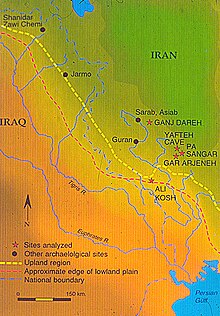Loading AI tools
From Wikipedia, the free encyclopedia
 Map showing location of Ali Kosh and other locations of early herding activity | |
 Neolithic sites in Iran | |
| Location | Ilam Province |
|---|---|
| Region | Iran |
| Diameter | 135 m |
| History | |
| Founded | c. 7500 BC |
| Cultures | Pre-Pottery Neolithic |
| Site notes | |
| Discovered | 1960s |
| Archaeologists | |

Ali Kosh is a small Tell of the Early Neolithic period located in Ilam Province in west Iran, in the Zagros Mountains.[1] It was excavated by Frank Hole and Kent Flannery in the 1960s.[2]
The site is about 135 m in diameter.[3]
Research has found three phases of occupation of the site. The exact length of the occupation is debated; earlier authors saw the site as inhabited over an almost 2,000 year period, starting from about 9,500 years ago (7500 BCE).[3] But recent (2018) analysis indicates only a 1000 year occupation.[4]
The site was occupied originally by pre-pottery peoples.[5] Pottery was introduced to Ali Kosh during the third phase of its occupation. Nearby Chogha Sefid has only one pre-pottery phase, after which the occupation extended into the Chalcolithic period.[6]

Three phases of occupations have been identified.
Bus Mordeh phase started around 7500 BC.[7] The settlement began as a group of small, rectangular houses with several rooms made of rammed earth. The occupants develop an economy based on the herding of sheep, goats, hunting and gathering wild plants.
This phase is dated around 7250-7000 BC. With larger houses, the deceased are buried under the house floors, sometimes with various burial gifts. The skull deformation using bandages during childhood is introduced, possibly as a sign of the different status of the bearers. The economy shows a more intense agricultural base supported by fishing and shell-fishing as a complement to the diet.
This phase is dated 7000-6500 BC.[8] The houses are made of stone and a necropolis is established in the nearby area. The tools are made of flint, with some obsidian use. Polished stone containers, hand mills, mortars, and baskets (sometimes lined with pitch) are in use. Ceramics appeared at the site during this period around 7000 B.C; decorated vases, and human and animal figurines are produced.[9] Some materials are imported from other areas, such as copper, and turquoise. There are also other links with the contemporary cultures of the Middle East. During the summer, the herds are moved to the grazing areas in the highland areas.
The settlement was no longer occupied after this time.
Ali Kosh was the earliest agricultural community in western Iran, where emmer was already cultivated in the eighth millennium BC. This crop was not native to the area. Wild two-row hulled barley was also present. Goats and sheep were also herded.[10]
Similar site on the Deh Luran plain is Chogha Sefid, and also Tepe Abdul Hosein in Luristan. All three have similar stone tools. Ganj Dareh in Luristan (seen on the map), also similar, is even somewhat older than these.[11][12]
Human remains from the area have been analyzed in 2016 for their ancestry. Researchers sequenced the genome from a 30-50 year old woman from Ganj Dareh. mtDNA analysis shows that she belonged to Haplogroup X (mtDNA).[13]
In 2017, several skeletons were found by archaeologists in Ali Kosh. 7 crania were found, all showing the evidence of ritual cranial deformation.
Previously, similar crania were already excavated in the area by Hole and Flannery.[17]
Another unusual cultural practice observed by researchers in these skulls was the ritual front tooth avulsion (removal of one or more teeth). Such a practice was quite common around the world in ancient times.[18]
According to these researchers, such a custom has not been previously reported for the eastern part of the Fertile Crescent.[21]
Seamless Wikipedia browsing. On steroids.
Every time you click a link to Wikipedia, Wiktionary or Wikiquote in your browser's search results, it will show the modern Wikiwand interface.
Wikiwand extension is a five stars, simple, with minimum permission required to keep your browsing private, safe and transparent.